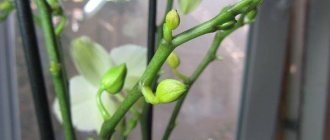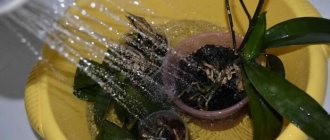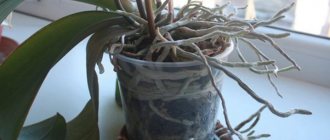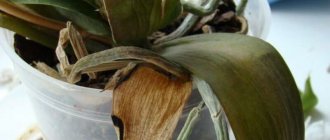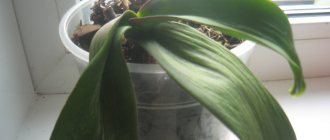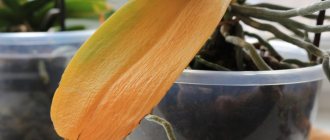How to understand that an orchid is dying?
If the plant begins to show signs of drying out, rotting roots, wilting leaves, etc., this may be either a natural process or a consequence of improper actions by the grower.
Signs of need for resuscitation
To prevent the orchid from completely dying, it is necessary to take immediate action if there are even the slightest signs that the plant needs help. You should pay attention to such manifestations as:
- the leaves on the flower not only turn yellow, but also wither;
- flower stalks dry out prematurely;
- Not only leaves and flowers fall from the stem, but even buds;
- the foliage becomes dull, glossy shine and turgor (elasticity) are lost;
- the root system fades and “wrinkles” form on it;
- the trunk of the flower takes on an unnatural dark shade;
- the roots have become gray or gray-green.
rotten roots turn yellow and wither leaves rot and wither roots
An orchid's root system should be silver or silver-green, and after watering it becomes a rich green color. Withering of the flower and flower stalk can be a natural process, but only when the indoor plant has finished its flowering period.
Methods for preventing and saving peduncles
If an orchid has dropped its flowers, what to do next depends on the cause and accompanying signs:
- If there is a lack of sunlight in autumn and winter, fluorescent lamps are installed, which can artificially extend daylight hours.
- If the green roots have turned gray, and there is no condensation on the walls of the container with the orchid, then the flower needs watering. The main thing is not to overwater or dry out the soil.
- If the stem turns yellow and the plant overheats, then it needs to be moved to another place away from the heating devices. This will save the orchid from dry air.
- If there is a high temperature in the room with the flower, then it must be sprayed. Periodic spraying of the entire stem will help the plant not to dry out.
- You should not leave the orchid in direct sunlight, otherwise burns will appear on the leaves. It is best to place the flower in a shaded place or make a barrier from bright light using reflective paper.
Fertilizer is equally important for every flower growing in pots. Without additional feeding, they will not be able to receive the necessary elements for development and will not bloom - there is not enough strength for this
It is necessary to feed the stem at the moment when the flower begins to grow green leaves and releases a flower arrow. If an orchid drops buds, you need to fertilize it in this way:
- leave it in water for a while so that the beneficial components are absorbed into the root system as best as possible;
- then dilute the fertilizer in water and keep it in this solution for another 20 minutes;
- After the time has passed, remove the container and allow the water to drain.
Attention! After feeding, you need to pay attention to whether the solution remains in the pan, because the accumulated liquid will burn the roots of the orchid.
Phalaenopsis does not like this, so you need to drain the solution every time it appears. Fertilize the plant with root fertilizers once every couple of weeks, and use foliar fertilizers between them, but the simultaneous use of both fertilizers is not advisable. If you use everything correctly and according to the instructions, then the fallen buds will be replaced with new ones.
Everyone who wants to buy a flower immediately becomes a fan of this plant, and some gardeners also collect different varieties. If the necessary conditions are not provided, the buds will soon disappear. To prevent the phalaenopsis from throwing off its last leaves, you need to carefully care for it, and then the orchid will become more and more magnificent.
The reasons why orchid flowers fall off have been clarified, as well as how to predict them. And in order for the plant to bloom again, you need to follow the rules of care: provide the necessary lighting, water and fertilize on time, and keep it in comfortable conditions.
Why an orchid dies: main reasons
The main signs that indicate the presence of any diseases in an orchid can appear on the foliage and root system. For example, if the leaves show signs of yellowing or they begin to curl, wither and even fall off, this may mean that the flower was not properly cared for. If the roots darken or become black, this indicates that the indoor plant has signs of a disease that arose due to a development process that is uncharacteristic for it.
Improper watering
It is recommended to water the orchid in winter no more than 1-2 times a week , and in summer it is necessary to moisten the soil in the pot 2-3 times in 7 days . If the summer days are very hot, you can increase the amount of watering.
Irrigation should not be done from a watering can, as the water may be unevenly distributed in the flower pot. Therefore, it is recommended to place the flowerpot in a container with warm water for 10-25 minutes, and then pull it out and allow excess water to drain.
Dry indoor air
In the tropics there is quite humid air, orchids feel comfortable. 60-80% is considered favorable for a flower . If the indicators are below 40%, the plant will begin to replenish the lack of moisture from all its parts, from foliage, roots and even from flowers and peduncles. You can provide the necessary humidity by installing a humidifier in the room or periodically using a steam humidifier.
Drying roots and leaves
When the orchids begin to show signs of drying out roots and foliage, the cause may be improper watering. An unhealthy state of the root system also indicates a lack of nutrients in the soil.
Root damage
The unnatural appearance of the roots should alert the grower and push him to solve the problem. Drying of one of the main organs of the plant can be caused by:
- damage to roots during transplantation;
- insect pests appeared on the roots;
- the roots show signs of being damaged by a fungal disease.
It is important to try to preserve those roots that look healthy, and thereby revive the orchid, if possible.
High room temperature
Comfortable conditions for growing orchids indoors are considered to be high air humidity and temperatures within +16-+28 degrees. If the room is hot, the plant will begin to wither or may even dry out.
It is recommended not to place orchids on the windowsill in direct sunlight in the summer. In winter, it is strictly forbidden to place the flowerpot near heating appliances.
Pests and diseases
What to do if the orchid has dried up: if signs of disease are detected on the plant, it must be immediately isolated from other flowers so that they do not become infected. Next, you need to find out what kind of disease and type of insects that caused the unhealthy appearance of the orchid. It is necessary to inspect the root system. As a result of stagnant water in the flowerpot, root rot may appear, and if appropriate measures are not taken in a timely manner, the plant will completely die.
Poor quality soil
Orchids need a special substrate, which consists of stones, tree bark, twigs and peat. During irrigation, the soil gradually becomes compacted and can deteriorate if irrigation is carried out incorrectly. As a result, the soil becomes less breathable, and due to its deterioration, insufficient nutrients may reach the roots. To prevent the death of the plant, the substrate should be updated.
Incorrect feeding
As for orchids, they are very scrupulous about fertilizers. An excess of fertilizers can cause the death of a flower, and a lack of fertilizers often provokes chlorosis of the leaves. This applies to situations where quite a lot of potassium and phosphorus were added. Their excessive use can cause disruption of the absorption of zinc and other essential microelements.
The best option is to use a complex fertilizer, so the flower can receive all the required nutrients.
Each manufacturer of fertilizers for indoor plants indicates on the packaging instructions for their use. It also indicates the dosage. But in the case of orchids, it is recommended to reduce the indicated doses by half for adult seedlings, and by 4 times for young bushes and children.
How to save a plant
Even if it seems to you that nothing can be done about the orchid, this does not mean that you can simply throw it away. If you take a comprehensive approach to solving the problem, that is, create an optimal microclimate for the plant and provide competent care for it, you can hope for a positive result. Let's look at what exactly is required of you in detail.
Let's take care of the temperature
If an orchid stays in a well-lit area for too long, its leaves begin to wither and then dry out. You can eliminate the problem by moving the pot with the plant to a cool and shaded place for several hours.
To prevent the flower from overheating again, maintain the room temperature at +25 °C (maximum). At the same time, at night temperatures should not exceed +15 °C.
Let's set the watering mode
It is necessary to irrigate the orchid substrate not chaotically, but in a certain mode. Otherwise, the rhizome of the plant will suffer, and then its entire above-ground part. Monitor the level of moisture in the soil: if the earthen ball has dried out noticeably, it’s time to water it. The optimal regime is one watering every few weeks.
The need for regular irrigation of the substrate arises earlier if the humidity level in your home is low. Therefore, you need to monitor the condition of the soil regularly - this is the only way you can set individual moistening times for your orchid.
Applying fertilizers correctly
Sometimes the gardener’s desire to quickly achieve active growth and opening of buds from his own orchid turns into an illiterate approach to the process of applying fertilizers to the soil. If you overdo it, the result will be exactly the opposite of your expectations, since the orchid leaves will begin to turn yellow and fade.
Treat your flower with care: it is better to saturate the substrate with less nutrient mixtures than to overdo it. The optimal choice for a gardener is complex fertilizers for orchids or for indoor flowers in general.
During the period of active flower growth, be sure to add mixtures containing nitrogen. But when the orchid blooms, it is better to discard this component, since it stimulates the development of foliage, not buds.
Let's destroy pests
Even if you are growing a flower at home, this does not mean that it becomes immune to parasite invasion. However, it is quite possible to cope with it: to do this, you need to spray the plant with high-quality store-bought insecticides (Fitoverm, Actellik or Dekaris).
Some gardeners prefer to treat orchids with homemade compounds, but their effectiveness, of course, is significantly lower. One of the most popular ways to treat a flower with folk remedies is to use a solution of laundry soap. They need to spray the plant.
We will cure diseases
In most cases, the plant suffers from the appearance of fungal formations on the stems and leaves. They contribute to the development of serious infections that you need to learn to fight. The disease can be diagnosed by examining the plant carefully: its roots, as a rule, rot and the leaves dry out.
In this case, it is advisable to purchase preparations for treatment, and also refuse to apply fertilizers, so as not to harm the flower even more. You can treat the flower with “Fitosporin”, “Skor” or with the drug “Topsin-M”.
Take proper care of your home orchid, and you will not have problems with its rapid drying out.
Source
How to revive an orchid at home?
To bring the epiphyte back to life, it is necessary to carry out a series of resuscitation measures. It is important to adhere to the points that are presented below in the article.
Assessing the condition of the orchid
Before you begin resuscitation measures, you need to assess the condition of the flower and determine what caused its painful appearance. It is also recommended to analyze the conditions under which the flower is kept. For example, whether watering was carried out correctly, air temperature and humidity, and the degree of lighting were observed.
Rules for restoring an orchid
How to revive an orchid at home, a step-by-step guide presented in the form of rules. Once the reasons have been determined, restoration of the plant can begin. It is important to remember some nuances that will help achieve the desired result. The main ones are:
- You cannot immediately transplant a flower if it was in the sun, even if the light was diffused. You should place the pot with the plant in the shade for a while.
- When removing an orchid from the container where it grew, you need to hold it by the base. To pull out the seedling, you need to shake it slightly. If the root system is strongly strengthened in the flowerpot, you can place it in warm water for 30 minutes.
- Watering should be done carefully so that water does not fall on the inflorescences and leaf axils. This will reduce the risk of rotting of the stem and leaves. If moisture gets in, you must definitely remove it, for example, by blotting it with a napkin or placing the flower on the windowsill, but the sunlight should be diffused.
It is necessary to remove rotten parts of roots and foliage, and the cut site must be disinfected. You can make powder from activated carbon by first grinding it into powder.
Tools and materials
To carry out resuscitation measures, it is necessary to prepare appropriate tools and materials. In this case you will need:
- scissors or pruning shears (they must be sharp);
- solution required to disinfect instruments;
- hydrogen peroxide (3%);
- succinic acid;
- activated carbon in powder form;
- fungicides, for example, you can use “Fitosporin” or “Fundazol”.
Additionally, it is recommended to use a vitalizer, which is not only a growth stimulator, but also increases stress resistance in plants.
Inspection and treatment of roots
Before taking appropriate measures to save the flower, you should first carefully examine the root system. Next, you need to remove dead and damaged roots. Cut and clean to a healthy area, and then treat it with peroxide or sprinkle with powdered activated carbon.
The next stage consists of such actions. It is necessary to place the reanimated orchid in warm water (up to 35 degrees), adding vitalizer HB-101 (4 drops per 1 liter of water). Soaking time should be no more than 1 hour. After 60 minutes, the plant needs to be pulled out and allowed to dry for about 20-30 minutes. Then it is recommended to inspect the flower again; the living dry roots, which were light silver before the soaking procedure, will become dark green.
Stem problems
In a situation where traces of disease or damage by insect pests begin to appear on the stem, it is necessary to begin treating it. The presence of yellow or black spots on the flower trunk is also considered a cause for concern. Often such manifestations occur as a result of improper watering. The fact is that when irrigating, you need to avoid getting water into the leaf sinuses. The presence of liquid in them will lead to a rotting process, which can affect not only the growing points, but the entire stem. Therefore, damaged areas on the trunk should be removed and treated with “Fundazol” or “Fitosporin”
The leaves of the orchid are drying, what should I do?
When there are dried leaves on a flower, they must be removed, as they will drain life-giving moisture and nutrients from the plant. When removing, you need to take the leaf blade and tear it along the central vein. The torn leaf must be carefully removed (cut) from the trunk so as not to damage the aerial roots. Be sure to treat the cut area with cinnamon or activated carbon powder.
Transfer
One of the options for reviving a dried orchid is to transplant it into a new substrate. You can also use the old soil in which the plant grew, but it must be disinfected. For example, you can spill the substrate with a solution of potassium permanganate or plain boiled water (hot). It should be noted the nuances that must be observed when replanting a reanimated seedling. The main ones are:
- The substrate must be breathable and contain coarse pieces of coal and wood bark. Moss and coconut chips are not recommended for use at this stage.
- It is better to choose a flower pot from a transparent material, and it should also have a large number of holes that will ensure air circulation.
- The landing process is quite simple. First, you need to place expanded clay and large pieces of bark on the bottom of the container. The orchid should be carefully placed on them, and then the existing voids in the flowerpot should be filled with substrate.
If, after planting in a flower pot, the plant wobbles, then support sticks can be installed for fastening.
Watering and fertilizing
A weakened plant, after resuscitation and transplantation, must be watered with extreme caution. After all, a small number of roots are not able to fully absorb moisture. It is recommended to water using a shallow container, which should be placed under the flowerpot with flowers. Water needs to be poured into the stand, and added as it evaporates. It is better to use slightly warm, settled liquid.
As for fertilizing, in this case the best option is to use a fortified cocktail. It should contain the following components:
- B vitamins – 1 ampoule;
- sugar – 1 teaspoon;
- succinic acid – 1 tablet.
The indicated substances must be dissolved in 1 liter of water. It should not be used for watering, but for spraying. You should also wipe the leaf plates of the flower with the solution. After a month, you can feed the seedling with iron chelate.
Important! It is prohibited to use root-forming preparations to restore a plant if it has few roots or only a few leaves.
Resuscitation using a greenhouse
One of the best ways to revive an orchid at home is to create a mini-greenhouse for the plant. An analogue could be a small greenhouse. The designated structures provide the opportunity to provide the necessary conditions for flower restoration. This method must be used in compliance with certain rules. The main ones are:
- In order for the plant, namely the roots and leaves, to fully participate in photosynthesis, the greenhouse should be made as transparent as possible.
- The substrate or its component cannot be watered during the process of restoring the orchid; it can only be sprayed with water, and the irrigation procedure must be performed only around the edges.
- The location of the greenhouse or greenhouse should be well lit, but at the same time not exposed to direct sunlight.
- It is recommended to ventilate the greenhouse structure once every 2 days, for about 1 hour.
Additionally, it is necessary to wipe the leaves of the reanimated plant (if any) with succinic acid. This is a kind of feeding that will help replenish nutrients.
Restoration with sphagnum
The use of moss is also considered a good option, but in this case it is important that the sphagnum be of good quality. It must have the following properties:
- breathability;
- ability to absorb excess moisture;
- be bactericidal.
Sphagnum can be used to restore plants not only in greenhouses; it is often used in such cases without being placed in greenhouse structures.
In hydrogel
It is worth saying that hydrogel can be used only in extreme cases. This is due to the fact that the designated material maintains constant moisture, and the plant that has been reanimated is already weak. Constant humidity can lead to rotting of the salvaged flower. In this case, you need to combine the hydrogel with a growth stimulator and the plant must be periodically removed from the solution to dry. For the orchid to fully recover, the procedure of immersion in and removal from the hydrogel may take about 6 months.
In polystyrene foam
Orchids do not need tree bark or polystyrene foam added to the flowerpot. The components marked are for stability purposes only. The main nutrition of the flower is provided by photosynthesis, which occurs in the leaves and root system. The foam used to resuscitate the plant is nothing more than ballast, which will prevent the cutting or seedling from being completely immersed in water.
In aquarium
You can also use a regular aquarium as a greenhouse. It provides the opportunity to create similar conditions. This is maintaining appropriate temperature and humidity. In this case, you need to place the reanimated flower in an aquarium, cover it, for example, with film or transparent glass. This type of greenhouse should be ventilated 2-3 times a week.
Recovery with a hot shower
Very hot water can not only burn the plant, but also lead to its death. Therefore, using a hot shower, especially for a weakened plant, is quite risky. If other methods to revive the flower did not give the desired result, then as a last resort you can try a hot shower. This procedure must be carried out not only carefully, but also by following certain rules. To do this, you will need to initially water the epiphyte from above with water at room temperature, and after 15-20 minutes with water that does not exceed 45 degrees. It is not recommended to carry out water activities more than once every 2 weeks.
How to properly prune an orchid after flowering - watching the peduncle?
If you don’t wait for this moment, you can simply destroy the plant.
Most often, two methods are used: pruning just above a dormant bud, or almost at the base. However, if you shorten the peduncle from above, the growth of new stems will be slowed down. This happens because the plant begins to spend all its incoming energy on the growth of new buds.
For pruning at home, it is best to use garden pruners. It almost does not injure the plant, does not create burrs into which harmful microorganisms can easily penetrate. Before use, it is advisable to boil the tool or treat it with alcohol. After the procedure, the cut site is lubricated with activated carbon or iodine. Some orchids have a hollow stem that can get caught in water when watered, causing it to rot. To prevent the death of the plant, the wound can be closed with beeswax.
The peduncle has dried out - should we remove it completely?
After the peduncle has fulfilled its function, all the buds on it dry out. In this case, the arrow must be completely cut off. The orchid itself dries out its outdated peduncle and there is no need to force events by trying to shorten it ahead of time. A capricious plant may even die from improper care. The nutrients contained in the drying peduncle will support the orchid and make it healthier.
Once completely dry, prepare for trimming. To do this you will need pruning shears or special garden shears. Pruning should be done as close to the rosette of the bush as possible. Afterwards, it is advisable to sprinkle the wound with cinnamon powder or charcoal.
Sometimes it happens that the peduncle begins to dry out not for natural reasons, but due to a lack of moisture in the soil. In this case, it is enough to start watering the orchid regularly, and soon it will bloom. If there is too much moisture in the soil, then the best way to quickly improve the condition of the plant is to replant.
This is interesting: soil for orchids
How to determine whether there will be re-blooming?
Many orchid owners strive to ensure that they bloom endlessly. Unfortunately, this cannot continue forever, because the plant needs rest. The chance of re-blooming increases with the presence of dormant buds. The appearance of new stems and buds will also be a good sign.
With certain care for the orchid, the likelihood of re-blooming can be increased:
- keep the temperature in the range from +17 to +22 degrees Celsius;
- move the orchid to a bright room, but do not expose it to direct sunlight;
- do not allow excessive soil moisture, it can lead to the appearance of rot and fungus;
- Apply fertilizers in a timely manner.
It has been noticed that in mature plants cases of repeated flowering are observed much more often than in young ones. An orchid that is older than 2-3 years is considered mature. And for plants that are too young, repeated flowering can even be dangerous; it is especially undesirable for dwarf breeds.
Cutting the peduncle not to the base
If the peduncle is completely dry, then it is cut off to the base. But in some cases this is not necessary and it can simply be shortened. If the orchid has already faded, but the frog remains dense and elastic, then it is not necessary to cut it off at the root. Examine her for dormant buds. If they are, then trim a little higher.
Later, a strong branch will grow from the dormant bud, and after a few weeks a bud will appear. Sometimes the wait for re-blooming can take several months. In order to stimulate the formation of buds, it is practiced to reduce the level of watering and alternate between higher and lower temperatures. In some cases, the cut peduncle dries out; this may be caused by improper implementation of the stem shortening procedure or the poor condition of the orchid.
Ways to save an orchid in different situations
Depending on the condition of the epiphyte and the circumstances why the seedling withered, you can choose the methods of revival presented below.
The orchid has dropped all its leaves, but the roots are green
It is not uncommon for an orchid to bare its stem, but the root system looks healthy. Loss of all foliage may indicate problems with the flower that need to be addressed immediately. There is a possibility that the flower does not have enough light, so photosynthesis does not occur fully. Lack of moisture or its excess can also lead to leaf fall. The main thing is to eliminate the cause of the problem and the orchid will begin to recover.
Drying roots
When there is a lack of moisture, the epiphyte begins to form additional aerial roots to provide itself with nutrition. Excessive amounts of them lead to the fact that the plant not only withers, but dries out because it does not have enough moisture. If the roots become gray and soft when pressed, then the flower urgently needs to be watered.
The roots may dry out due to the use of hard water for irrigation. Also, the cause of drying out of the root system is excess fertilizer. It should be used less than the specified amount in the instructions.
Leaves wither and dry
The leaves of an orchid are drying up; what to do is the most common question among gardeners. Falling leaves can also be a natural process; for example, as a leaf ages, it cannot fully participate in photosynthesis. But the causes of lethargy are often:
- insufficient lighting in the room;
- the room temperature is lower than required;
- untimely or incorrect moistening of the substrate;
- Fertilizer application was not carried out correctly.
You should also pay attention to the likelihood of insect pests on the foliage or stem and on the roots, which suck life-giving juices from the plant.
The stem dies
When an orchid shows signs of stem death, it should be cut to a living place, and the cut area should be wrapped with a cotton swab or moss. It is necessary to periodically moisten the soft wrapper. If there is a baby on a healthy area of the stem, you can grow roots on it and then transplant it into a flowerpot.
No growth point
One of the difficult options in saving an orchid is the case when the flower does not have a growing point. This happens quite rarely, but such a problem can arise due to an infection that was not noticed in a timely manner. Such an infectious disease can appear as a result of rotting, due to improper watering or sunburn.
Reanimating a plant without a growing point is problematic. But if the flower has a strong immune system and a lot of vitality, then with proper care it is still possible to try to restore the orchid. The main thing to consider is the following nuances:
- The growth point should be treated, and then systemic drugs that can stop the pathogenic process inside the plant should be applied to this area. The best of them are considered to be “Fitolavin” and “Fundazol”. Similar fungicides are also suitable.
- Before using systemic medications, the growth point must be cleaned and sprinkled with activated carbon powder.
- After treatment with special preparations, the plant should be attached to a support and placed on the bark, which must be disinfected.
Then it is best to place the reanimated flower in a mini-greenhouse. It is impossible to water an orchid where there is practically no core. It is allowed to spray the bark located along the edges of the flowerpot.
Problems with the peduncle
If the peduncle dries out, it is necessary to remove it so that it does not suck the life-giving juices from the main flower. If yellowness appears on the peduncle or it begins to fade, and a baby is located on it, then the necessary measures should be taken to save it. In this situation, it is recommended to cover the baby with moss and sprinkle it with Kornevin. When a baby shows signs of damage, you can try to save it in a mini-greenhouse.
Buds and flowers wither
How can you tell that an orchid is dying if its buds and flowers begin to fade? In this case, the problem lies in the root system. Due to excess moisture, rot could occur on the roots. As a result, the development of the peduncle is inhibited and it begins to die off because it does not receive the necessary nutrition. As a result, the buds and flowers that have managed to bloom wither.
Also, the cause of lethargy, falling flowers and unopened buds can be depletion of the substrate, its compaction and greasy content. To restore the breathability of the soil where the epiphyte grows, it is recommended to soak it in distilled and boiled water, mixing them in equal proportions.
Orchid flowers are drying
The process of budding takes a lot of effort from the plant, because almost all of it is aimed at forming a flower. Opened buds can dry out if the orchid is not watered in a timely manner, or if it experienced stress during transplantation. Perhaps the seedling is overcooled because the air temperature in the room is lower than necessary.
Epiphyte problems
Doesn't release an arrow
If all care requirements are met, the orchid blooms once a year (maybe more often). Why sometimes doesn’t she put out a peduncle? There are a number of reasons for this. Insufficient lighting, incorrectly chosen substrate, lack of fertilizing, stressed state of the plant, improper watering - this is a list of the main negative factors affecting the condition of the epiphyte, and, consequently, its desire to bloom.
If the orchid does not have enough lighting, then it does not produce a peduncle, but increases the mass of leaves. And when a peduncle appears, buds do not form on the shoot. The way out of the situation is simple: increase the volume of light, but avoid direct sunlight
In the summer, it is important to remember about shading the plant. If the substrate is chosen incorrectly or the plant is not fertilized, then the gardener does not need to harbor hopes of seeing his beauty bloom. It is important to remember that the epiphyte loves moderation in everything: an excess of fertilizers can also negatively affect the condition of the plant. For feeding, it is better to use complex preparations intended only for orchids and purchased at a flower shop
For example, “Kemira Lux” or “Bona Forte”. Before use, be sure to read the instructions for these fertilizers. The same applies to the substrate: for planting or replanting an orchid, soil is used that is intended only for this flower.
Stress has two opposite sides. Sometimes experienced gardeners give their orchid “shock therapy” so that it produces a peduncle (cold, drought, darkness). But stress can have a detrimental effect on a flower. Be sure to remember that everything is good in moderation. Watering an orchid is one of the basics of flowering. Moisture affects the formation of future peduncles and buds. If the epiphyte is watered excessively, the root system will certainly begin to rot and the buds will dry out. During the growing season, watering should be systematic, and after the buds appear, the frequency of watering is usually reduced. For the appearance of a peduncle, it is recommended to place the container with the orchid in a water bath for 1 hour; during the dormant period, watering stops completely.
Humidity. Orchid is a tropical plant that loves moist air. But not during the period of release of the peduncle. The humidity level in the room where the epiphyte is located should not exceed 30% - 40%.
From the video you will learn why an orchid does not produce a peduncle:
The arrow is released, but does not develop
Sometimes the flower stalk stops growing; there may be a number of reasons for this, which are almost identical to those listed above.
- Insufficient lighting. The solution is to move the plant to a more illuminated place.
- Rotten roots. The solution must be radical: the plant needs to be replanted. And although it is not recommended to do this during the release of the peduncle, here we are talking about the life of the entire flower as a whole.
- Insufficient watering. The solution is to adjust the watering scheme. You can cover the top layer of the substrate with sphagnum moss, which will promote additional moisture and also change the acidity of the substrate, after which the peduncle can begin to grow again.
The period of growth of the peduncle - from the moment of appearance until the appearance of the first flowers - is usually about two months.
Dries up
Sometimes the almost grown peduncle begins to dry out. Why? Here are some main reasons:
- Reaction to transplantation. The plant adapts to the new substrate and “sheds” excess parts. As a rule, these are the peduncle and lower leaves.
- No difference between day and night temperatures. In bright sunshine, all metabolic processes in the orchid begin to accelerate, new cells begin to form, and for them the flower needs carbon. The supply of this element is replenished during the cool night time. If it is hot at night, the plant begins to experience a lack of carbon, and, therefore, takes what is missing from its old cells. The largest reserve of carbon is contained in the peduncle, so it dies.
- Lack of nutrients: nitrogen, potassium, phosphorus. They are also “pumped out” by the plant from its parts.
As a way out of this situation, experienced flower growers recommend cutting off the drying peduncle to living tissue. This can stop the drying out, and a new side shoot may grow from the dormant bud. If this does not happen, then the arrow will have to be cut off completely, leaving a stump of 1-1.5 cm, and wait for the next peduncle a few months later.
Which orchids are more susceptible to drying out?
Orchids are considered quite capricious plants; the most problematic when grown at home are the following types of exotic flowers:
- "Aerides" is a difficult orchid to grow. Needs constantly moist soil (watering more than 3 times a week);
- “Vanda” - dries out and sheds its leaves when affected by a fungal infection (fusarium).
- "Dendrobium" - does not like drafts. The flowering period of an orchid is 2-4 weeks;
- “Cattleya” – if budding lasts less than 3 weeks, you should pay attention to this;
- "Phelenopis" - can bloom for up to 6 months under optimal conditions. It dries out most often when maintenance rules are violated.
In conclusion, it should be said that the cause of wilting or complete loss of foliage in an epiphyte can be an incorrect neighborhood. This flower is very temperamental and does not like to have its space constrained. Orchids also feel stressed when a houseplant with poor energy grows nearby. For example, it is recommended to place seedlings of yucca, cordyline and various types of succulents in another room altogether.
Why does the top bud dry out?
A fairly common question among beginning gardeners.
reasons :
- Perhaps the peduncle itself begins to dry after flowering;
- The second point is that the root system of the plant is weakened and cannot provide the plant with nutrients;
- If the stem dries out after cutting the plant, then the matter is due to incorrect actions.
By following all the steps for caring for an orchid, you can avoid drying out the upper bud of the flower.
With the correct sequence of actions , careful processing of the cuts, as well as proper care during the adaptation period, the plant quickly comes to its senses and continues to grow.
Basic methods of resuscitation if it dries out:
By the time the entire plant dries out, it will have exhausted its plastic substances and it will be impossible to save it. However, if the plant has dried only partially and living areas remain, then it is still possible to restore it:
In general, resuscitation of a dried orchid, in fact, is not much different from that if the plant had rotted.
Whole plant but roots are green
Since the roots and foliage are part of one plant and do not live on their own, assessing the viability of the orchid and deciding on further actions must be carried out based on the general condition of the plant. So, living roots are not a sign that it will survive. However, you can try to revive the plant in a mini-greenhouse.
Stem
If the stem begins to dry, then, obviously, the cause of drying is in the roots. Since the orchid stores moisture in its terrestrial organs (leaves or pseudobulbs), the fact that the roots have dried/rotted may not immediately become apparent. It often happens that green tops with more or less normal turgor sit in a pot without roots.
In order to revive the plant, it is pulled out of the pot, all dead sections of the roots are cut off and sent for intensive care or replanted. Care is being normalized.
Orchid with a dried stem.
Growth point
For a sympodial orchid, this is not scary . For monopodial, it means that the plant will stop growing. Sooner or later, after the leaves age and dry out, it will die. And before that, the orchid needs to be helped to reproduce itself, that is, to produce offspring - a baby. The shoots, as a rule, in this case appear on the side of the plant or at the roots.
Leaf mass
It is necessary to determine the cause of drying and correct the error. Usually, after correcting all the shortcomings in care and normalizing growth conditions, the plant itself recovers.
Root
Dried orchid roots.
Peduncle
Drying of the peduncle by an orchid is a normal phenomenon after flowering has completed. Not all species have perennial flower stalks. Therefore, when it dries completely, it must be removed. If only the top of the peduncle has dried up, then it is partially cut off, 2 cm above the dormant bud.
Orchid leaves
Process of natural dying
The natural process of renewal is characteristic of all plants growing on the planet, and orchids are no exception.
During the life cycle, simultaneously with the formation of new leaves, gradual aging of the lower leaf blades occurs , which is expressed in their yellowing and drying.
Moreover, each specimen can lose one, or very rarely two, leaves at a time, and the rest of the mass of leaves does not change its vital condition.
This phenomenon does not pose a danger to the orchid , which grows in microclimatic conditions suitable for it. Therefore, there is no need to worry and take any special measures - the completely dried leaf should be carefully separated from the stem, after which a circular ring will remain.
This is how leaves die off in orchids with an incomplete life cycle . If the tropical guest has a winter dormant period, then the leaves fall off every season, you can find that its leaves have fallen off, but the roots are alive.
Dendrobium in dormancy.
Lifespans of individual species
The lifespan of a leaf blade depends on the type of orchid, but on average it is about 3 years (vanda, phalaenopsis, vanilla). Some species (ludisia precious) are able to preserve leaves for up to 7 years.
And representatives of the deciduous group (dendrobium, calanthe, lycaste) shed their leaves immediately after flowering in preparation for the dormant period - their leaf lifespan is six months - a year or sometimes up to 2 years. In this case, you will see that the leaf blade has dried out, but the roots are green.
Instructions for action
When only the leaves fall
Many novice gardeners are concerned about the question: why have all the leaves fallen off, but the roots are still alive? If the green mass falls from the plant, there is no need to panic. First you need to figure out why the leaves turned yellow and fell off. Perhaps it is due to the aging of the flower. If not, then carefully examine the beauty to see which parts also look unhealthy. Then proceed with the following steps:
- review the features of care;
- move the flower to partial shade;
- exclude watering with tap water;
- remove the flower away if there are cordyline, yucca, peperomia or araucaria in the neighborhood;
- do not fertilize during the first two weeks, and then with weakly concentrated nitrogen-based preparations to increase the growth rate of young shoots;
- examine the orchid for the presence of small parasites or infections, if this is the reason, take immediate action;
- treat the plant with special chemicals;
- change the pot if necessary;
- update the soil.
When the flowers also fall
Improper care of the plant at home can lead to the question, why do the flowers turn yellow and fall off? One of the reasons may be a lack of fluid, which can occur in the complete absence of watering. The plant vitally needs a minimum volume of water, which dissolves the minerals in the soil and nourishes the root system. This is the reason why the leaves turn yellow, dry out and fall off, as well as the flowers dry up. Measures taken:
remove the orchid from the flowerpot; immerse in a basin of water until the earthen lump becomes limp (note that water should not get on the leaves); If necessary, place in a new pot.
Such symptoms indicate overfeeding of the exotic beauty with mineral fertilizers. Then we carry out the same activities, and for 2-3 months we should not add any nutrients.
When the roots disappear
This condition, unfortunately, is quite common. When the leaves fall, the root system also dies (we talked about whether it is possible to save an orchid without roots and leaves and how to do this here). If all the leaves of the plant have already fallen off, and the process has begun when the roots disappear, then there may be several reasons. This is possible when the soil is waterlogged, when liquid stagnates in the flowerpot and leaves and roots rot. Or with Fusarium wilt, caused by mold fungi (read about how to save an orchid from mold here, and from this article you will learn how to understand that a flood has occurred and how to save the plant).
If symptoms are detected, you should:
- disinfect pruning tools;
- take the flower out of the pot;
- soak the roots in warm, clean water;
- carefully examine and feel all the roots;
- trim damaged, soft, dry places with a prepared, sharp tool (read more about why orchid leaves become limp and how to fix this problem here);
- treat the sections with an antiseptic that does not contain alcohol (ground cinnamon, powdered activated carbon);
- to destroy or prevent infections, treat the flower with a fungicide;
- place the orchid in a new pot, it should be transparent and slightly cramped;
- mandatory presence of a drainage layer;
- sprinkle the plant with new soil enriched with minerals;
- you can fertilize after 2 weeks;
- optimize growing conditions, because it is possible to revive a flower only in a favorable environment.
When all the leaves have fallen
It happens that a plant has lost all its green mass, while the root system is alive and green. In this case:
- remove the orchid from the flowerpot;
- clear the soil;
- leave the roots in water for a couple of hours to replenish the liquid;
- inspect the root system and foliage for the presence of harmful insects;
- We also trim dry leaves to healthy tissue;
- We disinfect the cut areas;
- after the wounds have dried, place the flower in a flowerpot with new soil;
- we treat living kidneys with cytokinin ointment;
- use nitrogen fertilizing once every 7-10 days.
The ideal option is quarantine:
- Move the plant to a warm place with diffused sunlight.
- Control the frequency of watering and water quality.
- Minimize water treatments.
- Also carefully monitor the further condition of the orchid.
We tell you how to save an orchid without leaves, but with roots
In their natural habitat, leaf shedding in orchids occurs for natural reasons , and each leaf blade lives its allotted life, since the plants grow in their usual climatic conditions and are able to independently control their life cycles.
Once in home culture, orchids can adapt quite successfully to new conditions. But the microclimate for tropical beauties is created artificially, which means that the plants are completely dependent on human knowledge and accuracy.

